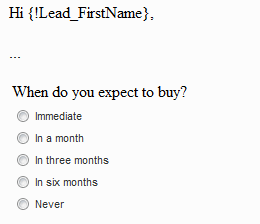Your first marketing automation project can be overwhelming – where do you start?
One way to look at this is to learn from other people’s mistakes. Knowing what not to do can often give you the insights you need to start off ‘on the right foot’, and the confidence to spend time and effort on the important things, and avoid the pitfalls. Basically, you get the benefit of someone else’s experience without having to make those same mistakes yourself – and waste time and money doing so.
The aim here is not to look down on others for their failures, but instead to applaud them for their courage in writing about them and giving us the opportunity to learn from them. The main points in the post were inspired by an article about a failed project [Marketing Automation – A Failure] – our thanks to the author who gave permission for this post.
Six ‘failure statements’ summarize the article – they are presented here.
1: “Our objectives for using a marketing automation product weren’t clear, and weren’t fully thought-through”
As mentioned in a previous post, there’s a delicate balance between planning and execution that is pivotal in driving success or failure of this – or any other kind of – project. Sometimes described as top-down vs bottom-up, it goes something like this: The overarching strategy needs to be articulated before anything else – otherwise you find that you don’t know where you are going. So think through your objectives fully and clearly. But if you spend too much time at the strategic level before thinking about how you will execute your strategy, you lay yourself open to paralysis – ie. nothing gets done because your strategic thinking is not (ie. ‘never’) ‘complete’.
A healthy design process includes a ‘flexible dynamic’ between strategy and execution, where each provides feedback to the other. This is akin to ‘agile’ processes as practiced in software development – and other – industries.
2: “We didn’t have a marketing process to automate”
The need to standardize and document the marketing process is not felt as strongly in smaller companies, where decision-making may be manifested in one or a few people. But this does not mean that there is no business process in the marketing department – only that it is in peoples’ heads. This includes not only things like steps in the process, but also things like the status of a customer or prospect. ie. Lead from company x is rated ‘warm’ or is regarded as ‘not qualified’.
The design of a well-functioning business process – such as a marketing process – is not a trivial task. It takes time and skill to perfect. Trial and error are ever-present factors. This is truer for larger companies than for smaller companies.
So smaller companies should take heart. If your marketing process has not yet been documented, this is not a recipe for failure – only a motivation to start. Apply the same principle as above – ie. take baby steps.
3: “We didn’t have enough leads to nurture”
This is a common lament for small companies. The best advice I can give for starting a marketing automation project is: Don’t, if you can already cope with the volume of leads that you have.
4: “We didn’t have the right content”
Sending people relevant content – at the right time – is one of the most important areas that you should focus on in your marketing automation efforts. This goes by many names, the latest being ‘content marketing’ – something you can spend a lot of time searching on and reading. Depending on your budget, you may want to outsource this if you don’t have the in-house resources. Watch this space for guidance on how to plan and produce your message content.
5: “We never really thought about harnessing the tool to communicate with existing customers”
Overheard at the water fountain: ‘There are no customers – only prospects’.
Well, this is not entirely true, and unless yours is a startup company, you most likely have a good sense of who your customers are.
The point is, however, that prospects have increasingly more ability to find out about your company, your products, and your services – with or without your help. And this goes for your customers too.
And given that you already have (some kind of) relationship with each one of your customers – whether weak or strong – it makes sense to take advantage of a marketing automation tool to reach them. You probably have more opportunities to connect with customers, as compared with prospects, because you can take advantage of existing touchpoints – especially if you use a marketing automation tool that employs triggered messaging, and is sensitive to changes in individual state. And you would naturally strengthen your relationships with your customers, which, as the lesson goes, would reduce your costs even further.
6: “We didn’t recycle leads”
Just because leads/prospects don’t respond quickly to your initial outreach efforts does not mean that they are ‘dead’. Far from it! The lesson of the long tail has application here, and you may want to read this post. This is an area where flexibility of your marketing automation tool makes a big difference, because what you do need is an easy ability to communicate, perhaps in a modified (slower) way, with leads who may still be interested in your product or service – when they are ready. Don’t give up on them!
Do you have a failed marketing automation project to report? Please let us know if you do.


